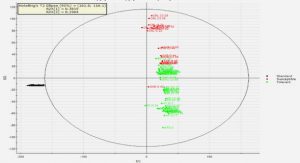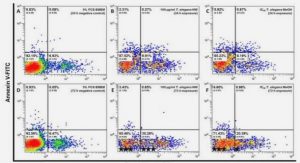Get Complete Project Material File(s) Now! »
LITERATURE REVIEW OF TITANIUM SINTERING
Chapter 1 gave a general introduction to this work and highlighted the issues to be addressed in this thesis. This chapter presents a general literature review in order to introduce the current state of knowledge of titanium sintering. More detailed literature relevant to each of the following chapters is reserved for the introductions to those chapters.
Introduction
Powder metallurgical technology is defined as the art and science of producing powders and of utilizing powders for the production of bulk materials and shaped objects [13, 31]. The concerns of feedstock powder handling processes include particle size distribution, particle shape, microstructure, impurities etc. Powder metallurgical processes, as related to the formation of bulk materials from powder, typically consist of three major steps. Initially, the powder is sieved to obtain the desired particle size distribution as feed material, followed by cold or hot compaction. In the compaction stage, the powder is pressed into a die or a mould to produce a cohesive structure near the dimensions of the final products (green body). The ultimate stage is the complicated but crucial process of sintering; a thermal treatment for bonding particles together into a strong solid structure via mass transportation that occurs largely at the atomic level [14]. Stages from powder handling, compaction and sintering are also present in specific titanium sintering.
Chapter 2: Literature Review 11
Basics of sintering process
Targets of titanium sintering
Sintering is classified into two types described as either solid phase sintering or liquid phase sintering. The process is defined as solid state sintering when the powder compact is sintered wholly in a solid state at the sintering temperature, while there is liquid phase present in liquid state sintering [32]. Most cases of titanium sintering belong to solid state sintering, such as sintering of c. p. titanium powders and sintering of pre-alloyed Ti-6Al-4V powders [33, 34]. Sintering can also be divided into pressureless sintering and pressure-assisted sintering depending on whether additional pressure is applied during sintering. Both can be seen in titanium sintering [9, 22, 35-38]. Pressure-assisted sintering can help to eliminate internal porosity and therefore densify specimens, while pressureless sintering is generally low-cost and beneficial to density homogeneity in conjunction with hot pressing [5].
The target of titanium sintering is to produce required near-net or net shapes with desired mechanical properties. Through suitably controlled sintering processes, the engineering properties such as strength, ductility, conductivity, magnetic permeability and corrosion resistance can be improved accordingly [14].
Stages of titanium sintering
The classic stages of sintering are outlined in Table 2-1 in regard to geometric categories for analysing the mass flow process [14].
Initial particle contacting is created in green compacts since powders are pressed together. At this stage, there is no grain or pore growth. After heating green compacts to a certain temperature, initial-stage sintering occurs and small amounts of densification and coarsening of grains and pores can be expected. In the intermediate-stage sintering, the pore structure becomes rounded and significant densification occurs. Since pores have a pinning effect against grain growth, the grain growth is not strong at this stage [14]. As the pores shrink and become isolated, extensive grain growth is observed in the final-stage of sintering because less grain boundary pinning occurs in comparison with the previous sintering stages. The process is also witnessed by solid-state titanium sintering conducted by the author as illustrated in Figure 2-1. C. p. HDH titanium powders (<75 m) in Figure 2-1 were sintered at three different temperatures under argon atmosphere with a pressure of 1.1 atm (1.11 × 105 Pa) in a graphite furnace. More detailed experimental work of these samples is described in Chapter 5, but these images are presented here to describe the general sintering process.
Remarkable grain growth is observed at the final-stage sintering when sintered at a temperature of 1400 ºC with a holding time of 4 hours in Figure 2-1 (c) in comparison with lower temperatures illustrated in Figure 2-1 (a) and (b). Porosity also decreased with increasing sintering temperature from 1100 ºC to 1400 ºC, which means the densification increased with the increment of temperature. Spherical pore closure was also witnessed at the final-stage sintering shown in Figure 2-1 (c) and the size of some pores were even larger than at lower temperature shown in Figure 2-1 (b). Such pore coarsening is suggested to result from the vacancy flow since large pores can be the vacancy sink and neighbouring pores are vacancy source [13].
Parameters of titanium sintering
The initial stage of sintering can be empirically modelled in terms of isothermal neck growth as measured by the neck size ratio [13, 14]:
where is the particle diameter, = neck diameter, = isothermal sintering time and is a collection of material and geometric constants. The values of , , depend on the mechanism of mass transport. The above empirical equation indicates that sintering is highly sensitive to the particle size, with a smaller particle size giving rise to more rapid sintering. The sintering data compiled by Robertson et al. confirms that a finer particle size is beneficial for titanium powder densification [16].
Therefore, it can be seen according to the discussion shown above that sintering temperature, particle size and particle size distribution are important variables to titanium sintering. The effects of these variables and levels will also be seen and discussed in other chapters in this thesis.
Manufacturing methods of titanium powders
With the target to reduce the cost of titanium components manufactured by powder metallurgy, generally there are two approaches currently under development. One is to optimize sintering variables and levels and apply new sintering approaches for example microwave-assisted sintering [39] to lower the production cost. This will be discussed later. The other approach is to develop novel production methods such as FCC-Cambridge process [40] and ITP-Armstrong process [41] aiming to lower the cost of powder feedstocks. Different production methods have varied characteristics summarized in Table 2-2 [42].
Among the production processes listed in Table 2-2, inexpensive HDH titanium powders produced from the mainstream Kroll process provide the most cost-affordable basis for current titanium sintering [7]. In the production of titanium sponge powders, the Kroll process is the mainstream process utilizing molten magnesium to reduce titanium tetrachloride [1], but is being modified by recently-developed processes [43-45], such as TiROTM [46, 47] because of continuous production capability and low cost. Ti sponge fines are hydrogenated, ground and then dehydrogenated in the production of HDH powders. However, in this process chloride is an inevitable impurity in HDH-produced titanium powders originating from the sponge production process in either the Kroll [1, 48, 49] or modified processes [43, 44, 46].
Effect of impurities in titanium powders on sintering
The impurity issues always exist in and affect titanium sintering especially from titanium powders including interstitial impurities (C, H, O, N) and chloride impurities originating from the production process.
Carbon and nitrogen
Carbon and nitrogen are not generally found at high concentrations in titanium specimens [50] because it is not common to be introduced from either titanium powder production processes or consolidation of titanium powders. There are exceptions however such as metal injection moulding [51-53]. The presence of polymer-based binders during powder injection moulding increases the chances of carbon contamination during sintering [26, 54]. Therefore, the debinding of the polymer is always a crucial issue in titanium injection moulding [54]. The effect of these impurities on the mechanical properties of titanium specimens is pronounced even at low concentration [50]. This can be understood from the solubility of carbon and nitrogen in titanium shown in Table 2-3 [55].
1. INTRODUCTION
1.1 Background
1.2 Research objectives and scope
1.2.1 Particle size
1.2.2 Compaction load
1.2.3 Time and temperature
1.2.4 Sintering atmoshpere
1.3 Outline of thesis
2. LITERATURE REVIEW OF TITANIUM SINTERING
2.1 Introduction
2.2 Basics of sintering process
2.2.1 Targets of titanium sintering
2.2.2 Stages of titanium sintering
2.2.3 Parameters of titanium sintering
2.3 Manufacturing methods of titanium powders
2.4 Effect of impurities in titanium powders on sintering
2.4.1 Carbon and nitrogen
2.4.2 Hydrogen
2.4.3 Oxygen
2.4.4 Chlorides
2.5 Effect of compaction pressure and methods on sintering
2.5.1 Cold compaction
2.5.2 Isostatic pressing
2.5.3 Equal channel angular pressing (ECAP)
2.6 Development of low-cost titanium alloys
2.6.1 Addition of iron
2.6.2 Addition of silicon
2.7 Review of novel sintering methods
2.7.1 Microwave-assisted sintering
2.7.2 Additive manufacturing (3D printing)
2.7.3 Spark plasma sintering
2.8 Problems and challenges in titanium sintering
3. EXPERIMENTAL METHODS
3.1 Experimental materials
3.2 Compaction and sintering
3.3 Density measurement and phase determination
3.4 Metallography preparation
3.5 Microstructural observation and semi-quantitative compositional analysis
3.6 Quantitative chemical composition analysis
3.7 Surface chemistry analysis
4. INVESTIGATION OF CHLORIDE IMPURITIES IN KROLL-PROCESSED HYDROGENATED-DEHYDROGENATED TITANIUM POWDERS
4.1 Introduction
4.2 Experimental
4.3 Results and discussion
4.4 Conclusions
5. EFFECT OF CONTAMINANTS ON MICROSTRUCTURAL EVOLUTION AND MECHANICAL PROPERTIES OF COMMERCIALLY PURE TITANIUM SINTERED IN A GRAPHITE FURNACE BACKFILLED WITH ARGON ATMOSPHERE
5.1 Introduction
5.2 Experimental
5.2.1 Materials, compaction and sintering
5.2.2 Characterization
5.2.3 Mechanical testing
5.3 Results
5.3.1 Density measurement
5.3.2 Metallography of the bulk sintered samples
5.3.3 Close-up observation of surface contaminants
5.3.4 Phase characterization of the surface and the interior
5.3.5 Mechanical properties and fractography
5.4 Discussion
5.4.1 Densification
5.4.2 Effect of interstitials on microstructure evolution and mechanical properties
5.5 Conclusions
6. EFFECT OF RESIDUAL CHLORIDE IMPURITIES ON COMMERCIALLY PURE TITANIUM SINTERED IN A GRAPHITE FURNACE
6.1 Introduction
6.2 Experimental
6.3 Results
6.3.1 Characterization of as-received Ti and Ti-6Al-4V powders
6.3.2 Surface microstructural observations
6.3.3 Metallography and microhardness of the bulk sintered specimens
6.4 Discussion
6.5 Conclusions
7. DEVELOPMENT OF A CLEAN SINTERING ENVIRONMENT IN A GRAPHITE FURNACE
7.1 Introduction
7.2 Experimental
7.3 Results
7.3.1 Density measurement
7.3.2 As-sintered surface morphological observation
7.3.3 Macrostructural cross-section observation
7.3.4 Mechanical properties and fractural morphology
7.4 Discussion
7.4.1 Origin of carbon source
7.4.2 Theoretical calculation of scale thickness based on Fick’s second law
7.4.3 Effect of contamination reduction solutions
7.4.4 Role of sintering atmosphere
7.5 Conclusions
8. PRESSURELESS SINTERING OF Ti-Al-V-Fe TITANIUM ALLOYS FROM ULTRAFINE HYDROGENATED-DEHYDROGENATED TITANIUM POWDER
8.1 Introduction
8.2 Experimental
8.2.1 Materials
8.2.2 Theoretical density measurement
8.2.3 Press-and-sinter
8.2.4 Characterization and mechanical testing
8.3 Results
8.3.1 Characteristics of as-received powders
8.3.2 Densification
8.3.3 Microstructure observation and compositional analysis
8.3.4 Phase determination
8.3.5 Mechanical properties and fractography
8.4 Discussion
8.4.1 Microporosity formation
8.4.2 Macroporosity formation
8.4.3 Microstructural evaluation and phase transformation
8.4.4 Mechanical properties
8.5 Conclusions
9. OVERALL SUMMARY AND KEY FINDINGS
10. CONCLUSIONS
11. FUTURE WORKS
11.1 Effect of chloride additions on titanium sintering
11.2 Effect of sintering atmosphere pressures on titanium sintering in a graphite furnace .. 168
11.3 Development of titanium alloys with ultrafine titanium powders using oxygen getter 168
12. REFERENCES
GET THE COMPLETE PROJECT






